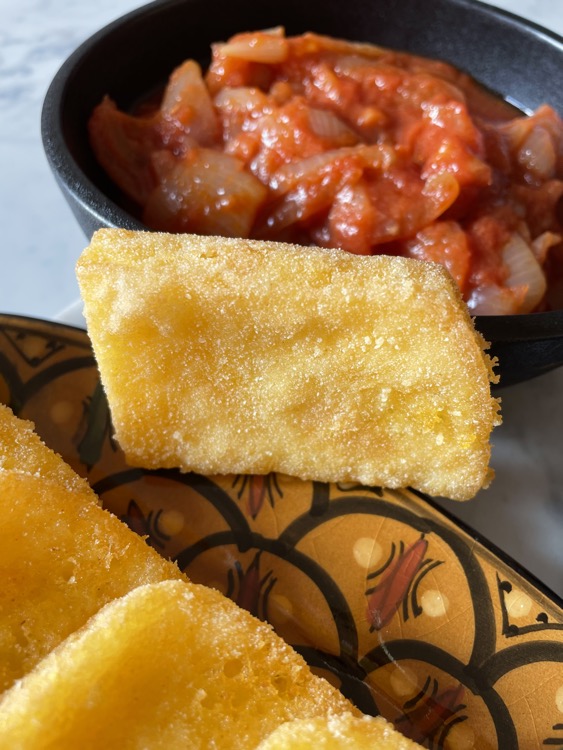Polenta warmed so many winter evenings of my childhood.
Warm and soft or firm and sliced and topped with melted cheese.
And, of course, fried polenta was always welcomed with joy.

The polenta
Grandma Sara often cooked polenta. In addition to the best-known one made with cornmeal, yellow or white, she also made it using chickpea or semolina flours.
I remember many different dishes, all equally enjoyed.
There was yellow polenta, soft and covered with ragù or accompanied by cheerful sausage stew. Then there was the chickpea one, soft, with musky octopus sauce. And the semolina with melted cheese also left a great memory.
Still today, I love polenta dishes.
They are versatile, easy to make, and cheap if that word doesn’t bother you.
For me, cheap cooking means intelligent cooking.
It is based on poor or seasonal ingredients cooked in a way that leaves the original flavor intact. Of course, economical cooking also contemplates reuse leftovers.
And it was from this idea that fried polenta was born, which, especially at one time, was a way to use leftover polenta.

My aunt’s fried polenta recipe
Aunt Iolanda, called Iole, was a devoted kitchen assistant to Grandma Sara, her sister. However, she was an expert on fried polenta and Romagna crescioni.
The preparation of polenta did not go unnoticed.
Grandma would get the copper pot from the cellar, the big one.
Auntie brought the water to a boil. Then she would add the cornmeal and stir for a long time, her face flushed with fatigue and the heat from the hotplate of the gas stove.
After cooking, the polenta cooled became solid, and rested for a long time, even overnight.
And after the slicing of the polenta, there was one last crucial step: the consultation of the women of the house with Aunt Iole’s response.
If Aunt Iole said “dry,” there was a kind of a silent sigh of relief.
But if she started saying a dismayed “ahi,” the polenta was still moist.
In this case, the aunt dried the polenta.
Do you know what happens if you fry polenta while it is still moist?
The oil swells and fills with bubbles produced by the water of the polenta, and the temperature drops.
But most importantly, the polenta stays soft and breaks down.
It is unbelievable how such an easy dish hides so many pitfalls.
By family tradition, I serve fried polenta with friggione and soft cheese.
At home, it was squacquerone, typical of Romagna, but each soft cheese will work well.
Finally, to make fried polenta, I use instant polenta.
I reduce the cooking time, and no one notices the difference.
Buona cucina, Monica

Iolanda’s tricks
Prepare the polenta the day in advance. When it is still hot, place it into a mold with sides.
Let rest for several hours or overnight out of the refrigerator (except in summer).
Cut into slices about 1/2 inch thick and assess for moisture.
If necessary, lay the slices on a dish towel without overlapping, and let them dry for a few hours.
To reduce the cooking time and the wetness of the polenta, I usually do one of these two things, following Auntie’s tricks.
1) I put the slices for a few minutes on the hot pan, or 2) lightly flour them with semolina. I usually choose the second option.
The slices are always a little moist. For this reason, I fry a few pieces at a time.
After dipping the polenta slices into the hot oil, I fry them for some minutes. Before moving it, I wait until the pieces rise to the surface from the bottom of the pan.
Fried polenta recipe
serves 4
ingredienti per circa 20 pezzi
120 g instant polenta flour
1/2 liter water
750 ml seed oil for frying
salt to taste
Directions
Bring salted water to a boil, pour in the cornmeal, and stir until smooth and soft.
Cool for a few minutes, then pour the mixture into a high-sided mold.
Let cool completely and rest for several hours or overnight. If you want to fry the polenta, never cut it while it is still warm.
Cut it into slices about 1/2 cm thick. If touching it still feels moist, read the advice above the recipe. If you are inexperienced in judging moisture, read the advice above the recipe.
Pour seed oil into a high-sided pan and, when very hot, add 2 or 3 slices of polenta.
Remember, don’t move the polenta until it rises to the surface on its own.
Wait a couple of minutes, and then turn the slices gently. If touching them breaks, it means they were moist and so will need an extra minute (read the tips above the recipe).
When the outside of the slices is golden brown, lay the fried polenta on paper towels and cover it with a kitchen towel to keep warm.
Serve and eat as soon as you finish frying.


